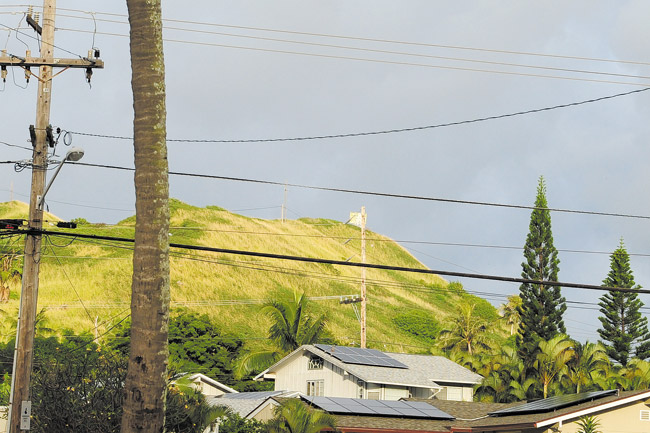A Monopoly’s Always A Good Buy

HECO’s new owner, NextEra, has not been friendly to rooftop solar
NATHALIE WALKER PHOTO, NWALKER@MIDWEEK.COM
Why would a Florida mega-electric company want to buy a small, mid-Pacific electric utility? Simple. That small, mid-Pacific electric company enjoys a near monopoly of energy generation in the state of Hawaii. A monopoly is always a bargain.
Why, then, would that small, mid-Pacific electric company want to sell to a utility headquartered half an ocean and an entire continent away?
The simple answer is the $4.7 billion that will find its way into the pockets of Hawaiian Electric Company shareholders.
The more complex answer lies in two crises facing those who sell electric power, one economic, the other of confidence. The public utility business model, according to people who use phrases like “business model,” no longer works.
Electric companies sell electricity, electricity that historically has been generated by burning oil or coal. In a state as blessed with alternative energy sources as Hawaii — and as cursed by transportation costs incurred by importing oil and coal — buying energy from an oil-burning utility doesn’t make sense.
Legislators, both state and national, have understood that and provided generous tax incentives to encourage Hawaii residents to purchase rooftop photovoltaic systems. Finally, HECO understood as well, but too late.
Its inability to adapt its infrastructure and business model to the new reality of energy consumers as producers turned it into a villain. As oil prices rose and solar panels covered more Hawaii homes, HECO couldn’t keep up with customers’ demand to connect to the grid. Solar-empaneled customers howled.
So HECO’s leaders want to sell, make a tidy profit for their investors and rid themselves of a headache. Those who run NextEra’s HECO can respond to customer complaints with “It’s corporate’s fault” — faceless corporate 5,000 miles away, somewhere south of Disney World.
And there will be more complaints. The picture of two utility executives alone whose incomes total more than $14 million announcing HECO’s sale should make a rate-payer pause.
Connie Lau, the $3.7 million HECO exec, explained: “In NextEra Energy Inc., Hawaiian Electric is gaining a trusted partner that can help the company accelerate its plans to achieve the clean energy future we all want for Hawaii.”
Jim Robo, the $10.3 million NextEra man, said it can, indeed, do better than HECO’s goal of 70 percent energy generation from renewables by 2030. A lot better.
That’s a big boast, a monster promise of the kind one might hear in an election year — or corporate merger season.
Can NextEra deliver?
Perhaps. It claims to be “the nation’s largest generator of wind and solar power,” according to the Honolulu Star-Advertiser.
Perhaps not. Robert Harris of Alliance for Solar Choice told the paper that “NextEra’s Florida operations have been historically hostile to rooftop solar and energy efficiency efforts. Florida is the ‘Sunshine
State,’ and yet only 2,565 of its customers have rooftop solar. This is a utility with more than 4.7 million customers.”
That compares with the 11 percent of Hawaiian Electric customers whose rooftops sport solar panels, roughly 48,000 homes and businesses.
Perhaps NextEra makes up in wind power what it has failed to produce in solar power. But therein lies another problem. Not all of Hawaii’s energy customers have applauded the mega-windmills that have sprouted on Hawaii’s North Shore or in the Maui mountains.
Rest easy. Gov. David Ige promises, “The state of Hawaii will do its due diligence to ensure the sale will be in the best interest for Hawaii ratepayers.”
Good luck on that, Guv.
dbboylan70@gmail.com





